The Qualcomm Snapdragon series that we are familiar with are not named according to routines.
Why should I say something again?
Because this time Qualcomm launched the Snapdragon 8 platform,
Because it is the first-generation product, it is called Snapdragon 8Gen1.

Wow this way of naming
When I first heard it, my first reaction was
What about USB3.2 Gen2
Is it exactly the same?
Although the naming is strange
But the 8Gen1 chip
But many of us are looking forward to it
Because Snapdragon 888 did not perform well this year
Poor energy consumption ratio leaves many mobile phone manufacturers at a loss
Can today’s Snapdragon 8Gen1 be ashamed?
Pushing the Android flagship to a new level?

Let’s take a look
First, explain
Our test this time is
Do it on a machine that hasn’t been released yet
So obviously to avoid suspicion
I can’t tell you which machine it is
Although this machine has not been lifted
But Snapdragon 8 Gen1 has been lifted
So we only talk about 8Gen1 today
Let’s take a good look at its performance and power consumption
before this
Let’s take a look at the 8Gen1 architecture first
One of the key changes in 8Gen1 is
It is the first to support the newly released ARMv9 instruction set

Some audiophiles may know
Upgraded from ARMv7 to ARMv8 in 2013
The improvement is huge

The mobile phone processor has evolved directly from 32-bit to 64-bit
Apple also used this to seize the opportunity back then
Made a powerful A7 chip

Caught Qualcomm by surprise
This time ARMv9 is not as disruptive as ARMv8

Especially the direct impact on performance should be small
It mainly made some improvements for security and scalability
In our opinion, one of the most important features of ARMv9
Is the addition of the SVE2 instruction set
The ARM processors on our mobile phones in the past
And the desktop side also has the ARM processor on the supercomputer
Although they are all ARM chips
But the width of the vector register is completely different
The mobile phone chip only supports 128-bit vector length
The desktop may have 256 bits
The supercomputer server can reach 512 or even 1024 bits

This means that the program you design for the supercomputer chip
It can’t be easily run on a mobile phone
But after having SVE2
The situation is different
It breaks the shackles of vector length
Developers only need to compile once
You can use the mobile phone chip and the desktop chip at the same time
And supercomputer can run
So there may be some algorithms designed for supercomputing in the future
You can run on your phone
to be honest
This is very beneficial to the construction of the ARM ecosystem
It can also be seen that ARM wants to occupy the PC
Ambition to occupy the supercomputing market
But going back to talk about this for performance
There will be no direct impact at the moment
ARMv9 is something for the future
Compare performance
Instead, it’s the new core architecture adopted by 8Gen1 this time.
Upgrade to Cortex-X2
China Nuclear Upgrade A710
Nucleus MINI finally replaced the A55
Upgraded to the brand new A510
This X2 big core is actually compared to X1
The improvement is not that big
The pipeline is reduced to 10 stages
The out-of-order execution window is slightly enlarged
Also made improvements to branch prediction
The most important thing is to completely remove support for 32-bit programs

This X2 big core is pure 64-bit
But in essence, it is still not a brand new architecture
ARM’s current mid-core and super-large cores
Was designed by the Austin team
These years have been improved on the basis of A76
A truly disruptive new kernel design
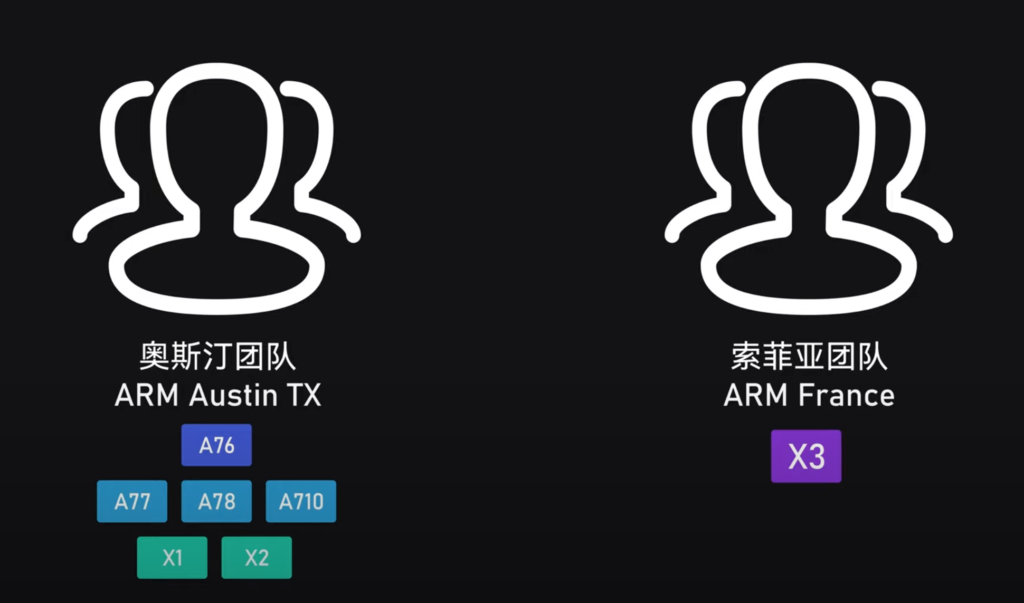
It’s not until next year that the Sophia team will bring
So I actually look forward to the performance of X3 next year
Including the new Cortex-A710
Compared with Cortex-A78, there will not be much performance improvement
But from ARM’s PPT
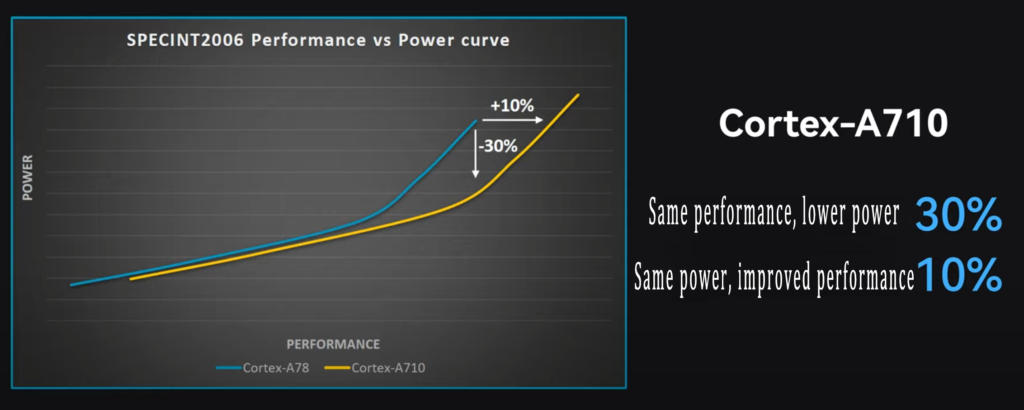
Power consumption seems quite worth looking forward to
Cortex-A710 has a very special place
It is the only one that retains 32-bit support among the three cores
According to ARM, it is specifically considered for the Chinese market
Because there are still a lot of 32-bit software in China
So need a little transition period
OK
The most worth talking about among the three cores
It’s actually a small core A510
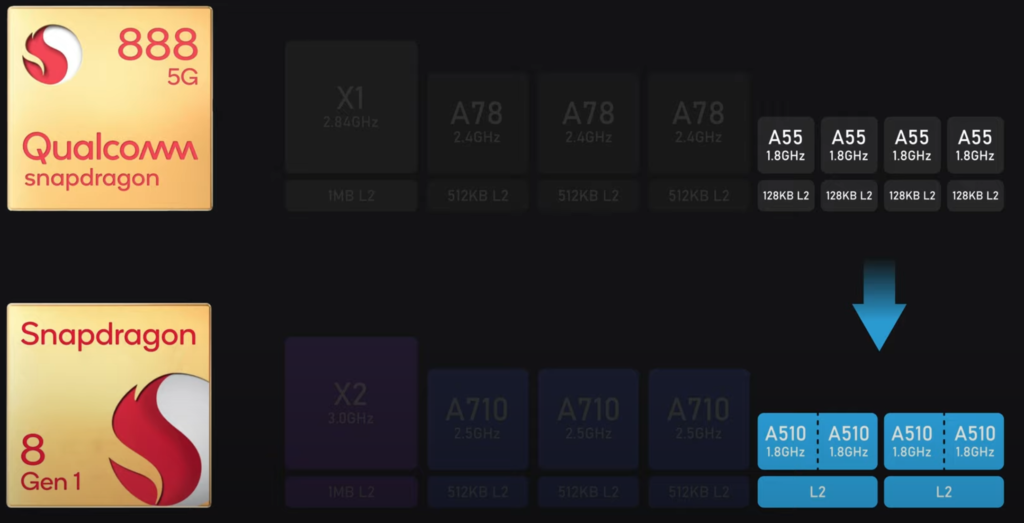
A510 is the ARM Cambridge team
The core of a completely new design
Finally eliminated Wannian A55
Performance according to ARM’s statement
Can be 35% to 50% stronger than A55 IPC

The progress is indeed obvious
But this improvement is mainly due to widening and increasing
For example, upgrade to 3 decodings 3 launch
3 groups of ALU at the back end
So the energy consumption ratio is actually not much improved
You can say that this A510 is much stronger
But not necessarily energy saving

The most critical
It is still a sequential execution processor
So even bigger it is destined to be a small core
But A510 has a very special design
Each core itself is incomplete
But to form a cluster with two cores

Shared L2 cache and floating-point part
This is a bit like AMD’s design on a bulldozer
The bulldozer was miserable by this design.
But I think it’s quite appropriate to put it here A510
Because of small nuclei like this
More often it is used to handle background work
Integer calls are indeed significantly more frequent
Floating point is actually not very useful
So I understand this shared design
Theoretically can improve efficiency
I am quite curious about the performance of this A510
Not only the large, medium, and small cores have been replaced with new architectures
The L3 cache of 8Gen1 is also larger than 888
From 4M to 6M

But 6M is still not full of blood
Full blood is 8M
Caching usually has a big impact on the game
Does this improvement help?
The answer will be revealed later
8Gen1 seems to be a continuation of 888+ on CPU fixed frequency
The big core is pulled to 3GHz compared to 888
Considering the frequency set by Dimensity 9000 next door

I think Qualcomm is still slightly conservative
But the manufacturing process
8Gen1 still uses
Samsung craftsmanship that everyone is very familiar with
Although upgraded to 4nm
But this is also improved from 5nm
Everyone can see what Samsung 5nm is
So what is the energy consumption ratio?
I still care very much
But what I care about most is actually the GPU part
Different from CPU

8Gen1’s GPU changes are still great
Finally eliminated the Adreno 600 series that had been used for 4 years

Upgraded to Adreno 730
GPU of the previous Android camp
Already behind the iPhone too much
So I am looking forward to the performance of Qualcomm’s new GPU.
What are its performance and power consumption
We’ll find out later
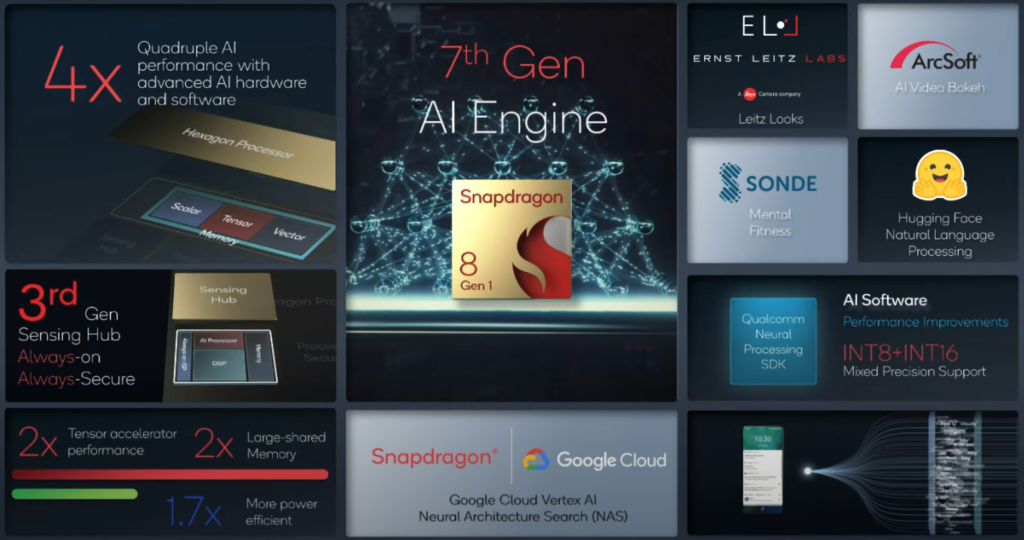
Other than that
The AI unit of 8Gen1 has also been greatly improved
ISP part of the upgrade is also very big

Can shoot 18-bit images
The tolerance is much higher than 888’s ISP
The baseband has also been upgraded to X65
Downlink speed can reach 10 Gigabit
It’s a big improvement
Look at it this way
This 8Gen1 seems to be inside and out
I changed everything
It’s really not as simple as changing the name
The change is quite big
But is its performance worthy of this new name?
We still have to take a good test and see
First of all, CPU performance is still the focus of our concern
So look directly at Geekbench 5

What is the situation with this CPU of 8Gen1?
3810 multi-core points
Only 60 points higher than 888
It’s just a 1.5% improvement.
Are you joking?
All big, medium, and small cores have been replaced
The result is a difference of 1.5%?
The single-core performance is also terrible
1200 points are also only 60 points better than 888
Increased by 5.7% only

Basically this single core of Snapdragon 8Gen1
Still does not exceed the A13 level
Considering the X2 core of 8Gen1
It’s already 3.0GHz
It has a higher frequency than 888’s X1
It’s not difficult to see that the X2 core is also a bit like squeezing toothpaste
Then the problem is coming
Single-core boost is limited
Multi-core performance is almost in place
Can your power consumption be optimized?
Unfortunately not
Snapdragon 8Gen1 CPU power consumption in GB5
Even higher than 888
Single-core 4.2W multi-core 11.1W
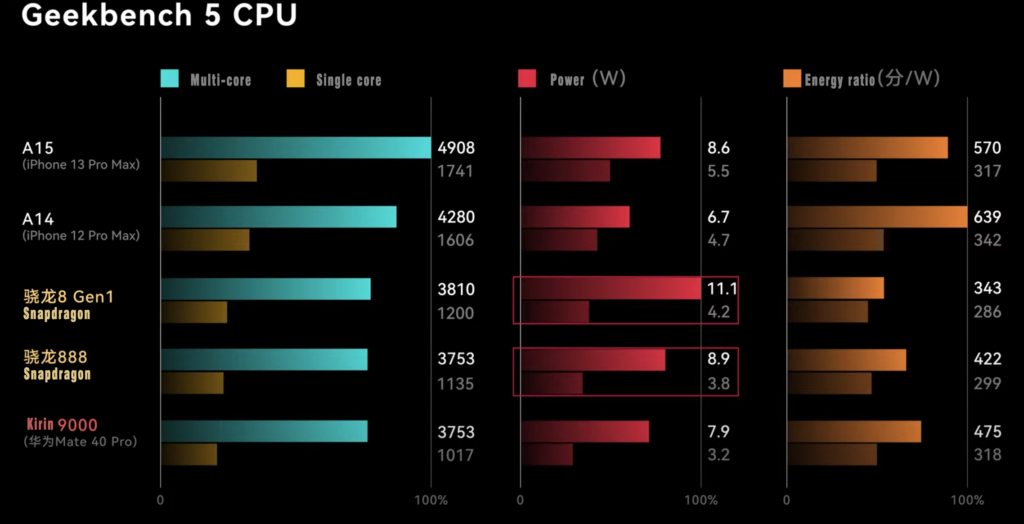
Do you want to keep the power consumption on par with the notebook?
It can be described as an electric tiger
Even if you look at the detailed power consumption curve we measured
Some projects can already reach 14W

This is horrible
With almost no improvement in multi-core performance
Power consumption can actually be higher than 2.2W
Isn’t this amazing?
I think one aspect is
We have been waiting for this new small core A510 for a long time
Completely disappointed our expectations
Performance
It didn’t bring much improvement in the energy consumption ratio.
On the other hand, the energy efficiency performance of Samsung’s 4nm process is still not optimistic.
Besides
8Gen1 also adds 2M level three cache
This may also bring a little power consumption
Of course, the three-slow improvement is actually not easy to reflect in the results of GB5
I can look forward to its effects when the game is tested later.
Anyway, the CPU part of 8Gen1
The Peak energy consumption ratio is quite bad
This CPU disappoints us a bit
But I also said before
What I am more looking forward to is the 8Gen1 GPU
How is the performance of this GPU?
Let’s run GFXBench and see
Hey wait a minute, what’s the situation?
Is this GPU better than A14?
No, 8Gen1 is even close to this GPU
Youth version A15

Qualcomm
This is something!
This is just OpenGL
Let’s run the Vulkan test again
Can already kill the residual blood A15
This GPU is pretty good
It’s almost 60% stronger than 888

Too scary
It seems that although Qualcomm has pulled a hand on the CPU
But the GPU did not neglect at all
Not bad
The performance of the new architecture of Adreno 700 is quite impressive
But your GPU is so powerful
Almost catching up with the A15 level
If the power consumption is not high
Isn’t it just hanging Apple?
So beautiful
Because the 8Gen1 GPU
Peak power consumption is higher than its CPU
When the performance of this GPU reaches the residual blood A15
Power consumption soared to 11.2W

Much higher than A15
The GPU power consumption is even close to M1
It is the mobile GPU with the highest peak power consumption we have ever tested
High-performance explosion, high power consumption explosion
That such a super large nuclear bomb GPU
Can you withstand the test of the baking machine?
We open the bright mountains
Run a durability test
8Gen1 seems to be doing pretty well here
The peak can already reach the level of A15
And here the down-frequency curve
It is smoother than the iPhone
But obviously such a big nuclear bomb
It’s impossible if you don’t want to reduce the frequency
Run down the Guangming Mountain in 10 minutes
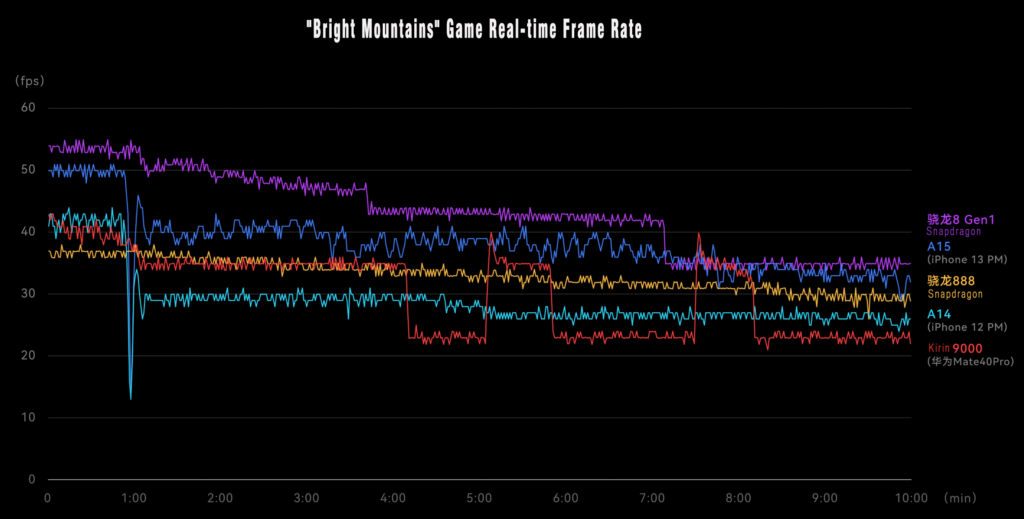
Probably will drop to the peak performance of 888
If we put more pressure on the GPU
Run longer
Run the 3DMark Wild Life Extreme stress test
Will eventually get 66.8% stability
Frequency reduction is quite serious
Although think about the good
Even if the GPU is completely reduced in frequency
Still better than the peak of 888

But this is obviously not a particularly energy-saving achievement
It seems that mobile phone manufacturers want to suppress 8Gen1 GPU
Still have to spend a lot of effort on heat dissipation
Although the peak GPU power consumption has exploded
But mobile phones don’t only have peak power consumption, right?
Now that I have changed to a new GPU architecture
Then you always have to improve the energy consumption ratio of some architectures.
I’m very curious
It’s under a slightly lower graphics load
If we reduce the load
How about the energy consumption ratio?
To test this
We designed a new project
Is the fixed load test of the Bright Mountains
We reduced the resolution to 1080P

Then run at 30 FPS
Simulate a slightly lower and uniform GPU load
Let’s take a look at the power consumption performance of these mobile GPUs under the same load
The result is this GPU of Snapdragon 8 Gen1
Medium load power consumption is not low

It is only slightly better than the most garbage 888
Compared to the 865, it’s still driving backward.
Co-author of the improvement of your architecture’s energy consumption ratio
In the end, it was all offset by Samsung craftsmanship?
This is an intermediate frequency performance
Many actual games will be close to this load
You said that if you just explode in peak load, it is excusable
Is the running score as strong as a tiger?
But if the game load is so bad
Then really don’t have to mix
This energy consumption ratio is just a joke
But these are all theoretical tests
In the actual game
What will be the performance of 8Gen1?
We still invite our old friend-the original god

The route is still our traditional night run map of Liyue Port
If you talk about CPU pressure
Liyue Port is even higher than the abyss
Mainly because the frequent loading here puts high demands on I/O
The platform that is slightly close is easy to freeze
So we still use this test
Before running the test
Still in accordance with international practice
I don’t know if it’s the reason why the new platform hasn’t adapted
The original god seems to be on 8Gen1
At present, the highest rendering resolution is 640P
Not standard 720P
Same as when we tested 888
But the image quality in the medium seems to be the same as other Android devices
Both are 568P resolution
Then our test is still the same as before
Divided into three types of loads
wifi+ medium picture quality medium load
wifi+highest picture quality 300 nits screen with high load
And 5G network + highest picture quality + 30 degrees room temperature devil load
To be reasonable
It’s not easy
First of all, look at the high load
That is, the highest quality wifi test
If you just watch the first 3 minutes
The performance of 8Gen1 seems to be pretty good
Although I only have 3 minutes

It’s almost a thread running at 60 frames
This has never been achieved on previous Qualcomm models
Check the frequency and you will find
The CPU scheduling in this section is also more aggressive
Therefore, the power consumption at this time is also relatively high
Will reach 7.6W of the whole machine
Obviously, this won’t last long
So after 3 minutes, the CPU will start to reduce the frequency one after another
Actually ran down for a 30-minute test
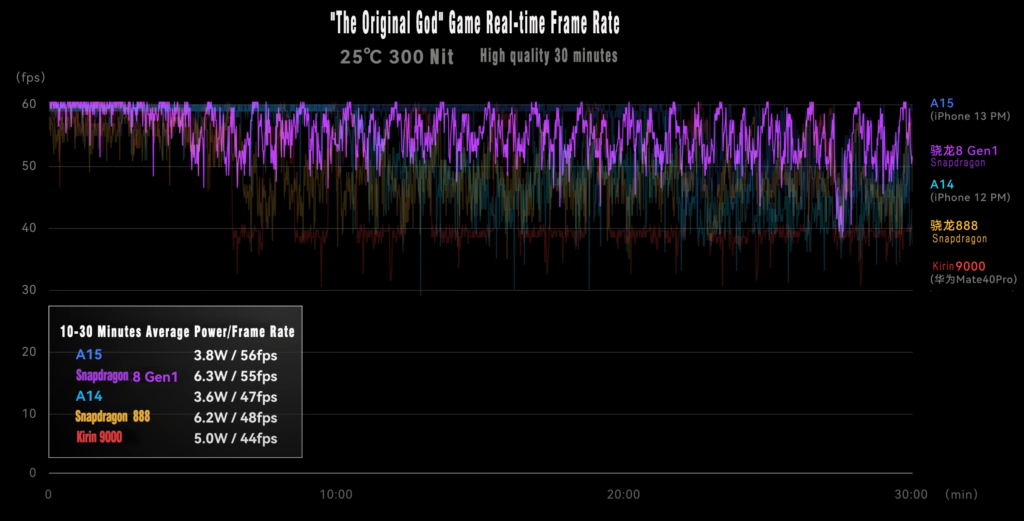
The final average number of frames will fall around 55 frames
The power consumption of the whole machine will be controlled at about 6.3W
In terms of power consumption, it is not lower than the 888 model.
But the number of frames has indeed increased
The game is smoother than 888
Some students will feel
Is this the credit of the GPU?
After all, this time the GPU is so strong
I don’t think it’s
You see, the GPU occupies only 56% on average
GPU load is very low
The improvement of the original god’s performance
I think it is the third level cache
6M three slow is really in the game

Greatly alleviated the CPU bottleneck
Look at it this way
Even if the CPU score and 888 can’t make the gap
But the performance of 8Gen1 in the actual game is pretty good
Of course, it’s a long way from Apple
But if your body can hold down for a long time
7.6W overall power consumption
The original god can indeed maintain full-frame operation
This is something that 888 can’t do even with a low resolution.
But I still want to remind everyone that this is only the performance of 640P now
720P GPU load will be higher
So the power consumption of the whole machine will be higher
Another concern is the body temperature
This phone runs for 30 minutes, the original god queen
The hottest spot is on the border
Can reach above 48 °c
Considering that the power consumption of this chip is still relatively high
This warm The performance is expected
Of course, the temperature of the phone also depends on your model
Let’s talk about high EQ
This generation of Qualcomm platform with the help of the heat dissipation carapace
The original god’s performance is very good
We also tried to reduce the image quality to medium quality
Unified 568P resolution
Running load test
The original god can indeed persist for a longer time to maintain the full-frame
About 6 minutes
In the future, there will still be slow frequency reduction
However, after 30 minutes, it can still maintain an average of 57 frames.
The fluency is indeed better than the 888 model
It’s a pity that this power consumption
It’s still about the same as 888
Finally
I believe you can’t wait to see the devil’s test.
We use 5G mobile network, 30 degrees room temperature, 300 nits screen
Play the original god with the highest picture quality
Baseband processor and screen heat up together
Let’s fully squeeze the potential of this phone
Unexpectedly under this load
8Gen1 ran out of the highest level of all models

Average 48 frames
Although in this state
The highest surface temperature of the phone has exceeded 53 degrees
Obviously, it’s too hot to hold
But the good news is that at least it didn’t crash
The number of game frames is also very stable
There is no drop to more than ten frames
Of course, this is also related to the heat dissipation of the model we are using
Anyway, the performance of this devil test is pretty good
In addition to CPU and GPU
We also tested the AI performance of NPU
Qualcomm replaced NPU on 8Gen1
Let’s measure the results of Geekbench ML

Compared to 888, the improvement is very obvious
However, there is still a certain gap with the industry benchmark A15
Of course, the main reason for this is
888’s AI performance is too bad
Not even as good as Dimensity 1200
Anyway, the AI performance of 8Gen1 is still qualified
In general
The results of this Snapdragon 8Gen1 test are mixed.
On the bright side
It brings us extremely terrifying GPU performance
The GPU of the Android camp can finally catch up with Apple’s pace
The increased three slowdowns of the CPU also make the original god run more smoothly
But the bad side
Peak power consumption is still very explosive
Sustained energy consumption is better than at most, which is better than 888
Still not so good
And the CPU improvement is too small
Minimal progress at the architectural level
I think the performance of Snapdragon 8Gen1
It’s definitely not a shame
But considering the GPU progress is indeed very large
So how can I give it a comment
It’s even higher than the useless 888
So it seems
The situation of 8Gen1 is a bit like the Snapdragon 820 back then.
We still hope that the next generation can have a 835 reincarnation.
All right
Today we tested the performance of Snapdragon 8Gen1 in more detail
I wonder if this 8Gen1 symbol does not meet your expectations?
To be honest, it was quite unexpected
I didn’t expect any CPU improvement
Power consumption is also a bit unexpected
But the GPU has improved so much
I didn’t expect
It should be said that this generation of game performance
It will largely depend on the cooling performance of the phone
Then the data of the Snapdragon 8Gen1 chip
We have also been included in the socpk ranking
Probably ranked here
Close to A14
Students who want to see us summarize detailed data
Welcome to socpk.com to check
See you next time bye












